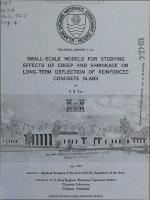Please use this identifier to cite or link to this item:
https://hdl.handle.net/11681/2434| Title: | Small-scale models for studying effects of creep and shrinkage on long-term deflection of reinforced concrete slabs |
| Authors: | United States. Assistant Secretary of the Army (R & D) Cox, F. B. (Frank B.) |
| Keywords: | Concrete shrinkage Concrete slabs Deflection Models Reinforced concrete |
| Publisher: | Concrete Laboratory (U.S.) Engineer Research and Development Center (U.S.) |
| Series/Report no.: | Technical report (U.S. Army Engineer Waterways Experiment Station) ; C-72-1. |
| Description: | Technical report Abstract: The objective of this study was to determine the feasibility of using small- scale models to study the effects of creep and shrinkage on long-term deflections of reinforced concrete slabs, and, if feasible, to deter mine (a) the smallest length scale (N) that can be reliably used to study these effects, (b) to what degree creep and shrinkage may affect model slabs loaded with either dead loads, dead loads plus estimated actual live loads, or dead load plus design live loads, and (c) if creep and shrinkage measurements obtained from model slabs can be correlated with those of standard laboratory specimens such as 6- by 12-in. cylindrical specimens. Strain and deflection readings were obtained on six simply supported square slabs for periods up to and slightly exceeding 1000 days. Similar readings were also obtained on corresponding slabs and 6-by12- in. cylindrical specimens positioned whereby the effects of shrinkage, creep, and autogenous volume change could be either investigated or correlated with the strain and deflection measurements from the test specimens. These limited tests indicate that (a) midspan deflections can be computed from actual strain measurements with considerable accuracy by the theory- of-elasticity equation ∆cs = 5/48(0) (L)2 if a parabolic distribution is assumed, (b) the theory of plates can be used to pr edict the elastic deflection of the slab, and then by applying the long-term factor prescribed by ACI Standard Building Code Requirements for Reinforced Concrete, ACI 318- 63, a fairly accurate estimation of the long-term deflections can be made, (c) a correlation factor can be derived from the strains of the slabs and those from corresponding 6- by12-in. cylindrical specimens and the deflections of the slab can be estimated with surprising accuracy, and (d) deflections predicted by equations derived from the theory of modeling differed from measured deflections by approximately 10 percent when model length scales up to 4 were maintained . This indicates that some of the unknown similitude requirements relating to permeability, thermal conductivity, etc., may not be of the same importance in reinforced concrete structures of this magnitude (nonmass structures) as the concrete mixture , reinforcing techniques , etc ., that are known and can be modeled sufficiently. However, it is emphasized that this is only one of many investigations needed before any conclusion can be considered final and not subject to change as new test results become available. |
| Rights: | Approved for public release; distribution is unlimited. |
| URI: | http://hdl.handle.net/11681/2434 |
| Appears in Collections: | Technical Report |
Files in This Item:
| File | Description | Size | Format | |
|---|---|---|---|---|
| TR-C-72-1.pdf | 10.19 MB | Adobe PDF |  View/Open |